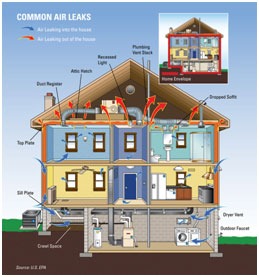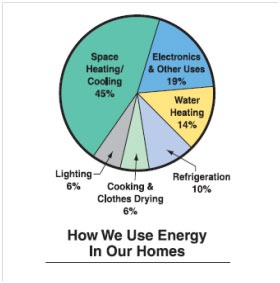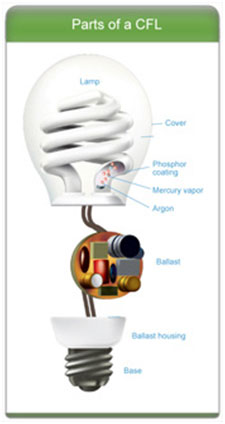 Your house is a system. How and where it sits on the property, known as ‘siting’, determines how it will be affected by the seasons and weather. The walls, roof, floor, windows, doors, and insulation make up the envelope of the structure. The heating and cooling, ventilation, and ductwork should work well separately and together for optimal performance.
Your house is a system. How and where it sits on the property, known as ‘siting’, determines how it will be affected by the seasons and weather. The walls, roof, floor, windows, doors, and insulation make up the envelope of the structure. The heating and cooling, ventilation, and ductwork should work well separately and together for optimal performance.
Siting
If your house is already built, it is impossible to adjust how it sits on the property. But if space permits, you can add arbors or plant deciduous trees on the south and west to provide shade during the summer, while letting in the sun in the winter.
If you are choosing to build a home, carefully consider how to site it for maximizing passive solar efficiency.
Envelope
To increase comfort and save on energy bills in your home check for and seal air leaks that might be costing you lots of money in energy bills.
Heating and Cooling
Heating and cooling the air in our homes accounts for up to 43 percent of our average annual energy bills.
- Install window treatments and keep them drawn to hold in the heat during the winter and keep it out on those hot summer days. There are materials available with insulating properties made just for this purpose.
- Install overhead fan(s) to circulate the heated or cooled air. Circulation alone can make it feel three degrees warmer in the winter or cooler in the summer.
- Add insulation to the attic and crawl space.
- Add insulation to the walls when making major renovations or before replacing siding.
- For more suggestions and resources, go to Clark Public Utilities.

Source: Clark Public Utilities 9/10
To get the most out of your current furnace while being as efficient as possible:
- Make sure it is properly maintained and serviced.
- Change furnace filters every three months or more often for allergies in a high traffic home.
- Set heat to 68° in the winter.
- Set air conditioning to 76° in the summer.
When replacing your heating system, choose from several high-performance options:
- 90-95 percent efficient furnace.
- Ductless heat pump (mini-split) which also provides air-conditioning.
- Ground-source heat pump.
- Consider installation of a heat recovery ventilator to efficiently introduce fresh air into your home.
Water Heater
- Lower the thermostat to 120°F. For each 10°F reduction, you can save between three to five percent in energy costs.
- If your water heater tank has less than R-24 insulation, carefully wrap it with additional insulation. Consult your utility for proper information and instructions.
- Insulate hot water pipes to reduce heat loss.
Appliances
When replacing appliances, choose new ones that carry the Energy Star label. Clark Public Utilities has incentives for its customers who buy certain Energy Star products. Clark Public Utilities will give you a credit on your utility bill and haul your old refrigerator away.
Refrigerator
- Keep it between 37°F and 40°F and your freezer at 5°F.
- Keep the evaporator coils at the bottom of the refrigerator clean to improve energy efficiency and lengthen its life. It’s easy to do: unplug it and remove the toe kick cover. Using the long, narrow nozzle on your vacuum or a specially designed refrigerator coil brush, carefully vacuum or brush away the dust from the coils and cooling fins. If there is a lot of dust on the coils and fins, your refrigerator works harder to keep your food cold, costing you more in your electrical bill, and shortening the life of your refrigerator.
Clothes dryers
Old dryers not only waste energy but also take longer to dry your clothes. There are no Energy Star ratings for dryers because energy use between models does not differ much.
Here are some hints to make your dryer more safe and efficient:
- Use the moisture sensor option. Many new clothes dryers come designed with a moisture sensor, which automatically shuts off the machine when clothes are dry. Not only will this save energy, but it will also save wear and tear on your clothes caused by over-drying.
- Clean the lint filter after every load to improve air circulation and increase the efficiency of the dryer. It’s also an important safety measure.
- Scrub the lint filter regularly if you use dryer sheets. Dryer sheets can leave a film on the filter that reduces air flow and, over time, can affect the performance of the motor. Use a toothbrush and water to scrub it clean once a month.
- Keep the dryer vent system clean. Dryer fires account for about 20,000 fires per year. To save energy and increase the life of your dryer, as well as reduce the chance of a dryer fire, follow the maintenance guidelines in your owner’s manual and learn how to safely clean lint buildup from your dryer’s exhaust vent pipe.
If you don’t feel qualified to clean the dryer vent system, hire a professional. A heating and air conditioning contractor can safely clean the dryer’s exhaust duct. Some insulation companies also work on exhaust and dryer ducts. Check their websites or call to find out.
Lights
Replacing outdated incandescent light bulbs provides an opportunity to pick energy efficiency’s lowest hanging fruit. Incandescent bulbs use about 75 percent of their energy draw to produce heat instead of light. There is a tremendous amount of energy savings to be had by simply adopting the newer technology of compact fluorescent lamps (CFLs) or light emitting diode (LED) bulbs. Always choose Energy Star qualified bulbs.
Check out these facts
- If just one light bulb in every American home was replaced with a light bulb that has earned the Energy Star rating, we could:
- save enough energy to light about three million homes for a year,
- save about $600 million in annual energy costs, and
- prevent nine billion pounds of greenhouse gas emissions per year, equivalent to the emissions from about 800,000 cars.
- There are four billion light bulb sockets in the U.S. and more than three billion of them still use the standard incandescent technology that hasn’t changed much in 125 years. A standard incandescent is only 10 percent efficient – the other 90 percent of the electricity it uses is lost as heat.
The new Energy Independence and Security Act of 2007, or “Light Bulb Law” (PDF), was signed by President George W. Bush on December 18, 2007 with the first phase effective January 2012. It provides standards for tremendous energy savings across the nation and is a technology neutral standard, meaning any type of bulb can be sold as long as it meets the efficiency requirements of the new light bulb standards.
Compare efficiency in light bulbs
Efficiency in light bulbs is measured by the number of lumens per watt they provide. Lumens measure a light bulb’s brightness. Watts are how much energy the light bulb uses. The new technologies produce significantly more lumens per watt:
| Type of bulb | Lumens per Watt |
| Standard 60 watt incandescent | 13-14 |
| Equivalent CFL | 55-70 |
| Equivalent LED | 60-100 |
Shopping for light bulbs
Since watts are more of an indicator of how much heat a light bulb produces, look for lumens instead:
| If you used to buy a bulb that was: | Look for a bulb with: |
| 100 watts | 1600 lumens |
| 75 watts | 1100 lumens |
| 60 watts | 800 lumens |
| 40 watts | 450 lumens |
CFLs – Look for the light color
The quality of light emitted by CFLs has improved drastically since their early days. Today you have a choice of light color, which is measured on a temperature scale referred to as Kelvin (K). Lower Kelvin numbers mean the light appears more yellow; higher Kelvin numbers produce light that is whiter or bluer. For comparison, the color of a standard incandescent bulb is about 2700-3000K. For a whiter light, look for bulbs marked 3500-4100K. For bluer light, look for bulbs marked 5000-6500K.
LED bulbs – Durability
Even though the price is still relatively high (but falling fast) for LED lights, one of the best reasons for using them is durability. Energy Star qualified LED bulbs have a projected life of 25,000 hours (or over 22 years at 3 hours per day). This can significantly reduce the number of times you need to change the bulb depending on how long you live in your home. People are installing LEDs in hard to reach light fixtures such as over stairways or in vaulted ceiling areas.
More facts on Energy Star Qualified LED bulbs
- Reduced energy costs — use at least 75 percent less energy than incandescent lighting, saving on operating expenses.
- Reduced cooling costs — LEDs produce very little heat.
- Guaranteed — come with a minimum three-year warranty, far beyond the industry standard.
- Convenient features — available with dimming on some indoor models and automatic daylight shut-off and motion sensors on some outdoor models.
- More durable — won’t break like an incandescent or even CFL bulb.
Fluorescent or tube style lights
Older style fluorescent, 1 ½” thick, T-12 light tubes with a magnetic ballast can be replaced with newer fixtures like the T-8 tubes, which use an electronic ballast that is more efficient, durable and won’t flicker and hum like magnetic ballasts as they age.
Motion sensors
Motion sensors or photo cells on exterior light fixtures can save a significant amount of energy. Motion sensors can also provide a useful “surprise” to animals or trespassers. There are even motion sensor light switches made for interior use. Check your local lighting specialty store or home center for product availability and advice.
Commercial / Industrial lighting
Businesses often use large amounts of energy to light their offices, warehouses, or factory floors. You can save significant amounts of energy by reassessing your lighting needs. Clark Public Utilities Commercial/ Industrial Lighting Incentive Program (CLIP) is a program designed to assist businesses with improving energy efficiency.
For the latest information available to help Clark Public Utility business customers, visit Clark Public Utilities Business Conservation Programs.
Services include:
On-site energy assessment
Commercial ductless heat pump program
Compressed air audits
Custom energy efficiency improvement projects
Network computer power management
Facts and figures are from Energy Star and US Energy Information Administration.
